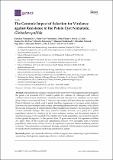The genomic impact of selection for virulence against resistance in the potato cyst nematode, Globodera pallida
Abstract
Although the use of natural resistance is the most effective management approach against the potato cyst nematode (PCN) Globodera pallida, the existence of pathotypes with different virulence characteristics constitutes a constraint towards this goal. Two resistance sources, GpaV (from Solanum vernei) and H3 from S. tuberosum ssp. andigena CPC2802 (from the Commonwealth Potato Collection) are widely used in potato breeding programmes in European potato industry. However, the use of resistant cultivars may drive strong selection towards virulence, which allows the increase in frequency of virulent alleles in the population and therefore, the emergence of highly virulent nematode lineages. This study aimed to identify Avirulence (Avr) genes in G. pallida populations selected for virulence on the above resistance sources, and the genomic impact of selection processes on the nematode. The selection drive in the populations was found to be specific to their genetic background. At the genomic level, 11 genes were found that represent candidate Avr genes. Most of the variant calls determining selection were associated with H3-selected populations, while many of them seem to be organised in genomic islands facilitating selection evolution. These phenotypic and genomic findings combined with histological studies performed revealed potential mechanisms underlying selection in G. pallida.
Citation
Varypatakis , K , Véronneau , P-Y , Thorpe , P , Cock , P J A , Tze- Yin Lim , J , Armstrong , M R , Janakowski , S , Sobczak , M , Hein , I , Mimee , B , Jones , J & Blok , V 2020 , ' The genomic impact of selection for virulence against resistance in the potato cyst nematode, Globodera pallida ' , Genes , vol. 11 , no. 12 , 1429 . https://doi.org/10.3390/genes11121429
Publication
Genes
Status
Peer reviewed
ISSN
2073-4425Type
Journal article
Description
This work was funded through an AHDB PhD award, the USDA GLOBAL Project and by the Rural and Environmental Science and Analytical Services division of the Scottish Government. Bioinformatics and computational analyses for the generation of the new G. pallida genome assembly were supported by the University of St Andrews Bioinformatics Unit, which is funded by a Wellcome Trust ISSF award (grant 105621/Z/14/Z).Collections
Items in the St Andrews Research Repository are protected by copyright, with all rights reserved, unless otherwise indicated.

